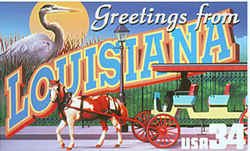
Louisiana Symbols
Louisiana State Amphibian
Green Tree frog

(Hyla cinerea)
Adopted on June 22, 1993
On April 12, Louisiana State Senators Jon D. Johnson and John J. Hainkel introduced Senate Bill 435 promoting adoption of the green tree frog, (Hyla cinerea,) as the official Louisiana state amphibian of Louisiana. On June 9, Senate Bill 435 was signed by the Speaker of the House. On June 10, Senate Bill 435 was signed by the President of the Senate and on June 22, 1993, the legislation was signed by Governor Edwin W. Edwards.
Louisiana's amphibian, the green tree frog (hyla cinerea) is also known as the Fried Bacon Frog, Cowbell Frog and the Bell Frog, and lives in swamps, borders of lakes and bayous, on floating vegetation, in trees and bushes near water, in Spanish moss or under bark on trees, and any place well supplied with water or dampness. They can often be found clinging to windows or window sills at night looking for insects that are attracted to light.
Louisiana State Amphibian: Green Tree frog

The green tree frog length varies from 32 to 57 centimeters, and their color is usually green but changes frequently. It has a cream
colored stripe with dark borders extending along the sides, and a dark stripe down the back. When calling, the color is almost yellow. They have a
distinctive calling sound, almost like "Duck! Duck!".
Besides being the state amphibian, the green tree frog is the basis for the well know Muppet character "Kermit the Frog".
Characteristics of the Green Tree frog

Common Names
Fried Bacon Frog, Cowbell Frog and the Bell Frog
Key Characters
Smooth skin; large toe pads; white or pale yellow stripe from upper lip to groin.
Indentification
Medium-sized (up to 6 cm SVL) bright green, yellowish green, olive green, or lime green frog with a few small splatters of gold or white. Belly clear pale yellow to white. Male slightly smaller than female. The male has a wrinkled throat indicating a vocal pouch.
Habitat
Open brushy borders of cypress swamps, floodplain sloughs, cattail marshes, lakes, and farm ponds.
Natural History
Adults and juveniles are seen on roads during and after rain. Diet consists of insects. Can change between dark and light green depending on temperature
and lighting. Perches by day on upright cattail or other plant while legs are tightly tucked under body. Breeds late May to August. Males call, sometimes
in large choruses, from button bush, swamp rose, lily pads, or other shoreline plants, and calls sound like a series of metallic honks, similar to
cow bells or barking dogs. Eggs are laid under water surface and are attached to roots of floating vegetation. Embryos hatch in a few days and tadpoles
transform in two months. Juveniles often feed in nearby grassy fields in late summer and autumn.
2012 Louisiana Revised Statutes
The law designating the green tree frog as the official Louisiana state amphibian is Section §169.1 (State amphibian) of the Louisiana Statutes, Title 49 (State administration) Section RS 49:169.1 (State amphibian)
Louisiana Revised Statutes, Title 49. Note that the name of the official amphibian is misspelled in the legislation. It reads "green tree frog" where it should read "green treefrog".
TITLE 49 - State administration
RS 49:169.1 - State amphibian
Universal Citation: LA Rev Stat § 49:169.1
§169.1. State amphibian
There shall be an official state amphibian. The official state amphibian shall be the green tree frog. Its use on official documents of the state and
with the insignia of the state is hereby authorized.
Acts 1993, No. 815, §1.
Taxonomic Hierarchy: Green Treefrog
Kingdom: Animalia - animals
Phylum: Chordata
Subphylum: Vertebrata
Class: Amphibia
Order: Anura
Family: Hylidae
Genus: Hyla
Species: Hyla cinerea







